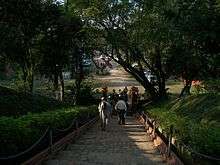Charaideo
Coordinates: 26°55′59″N 94°44′53″E / 26.933°N 94.7481°E

Charaideo was the first capital of the Ahom kingdom established by the first Ahom king Chao Lung Siu-Ka-Pha in 1228.[1]
It is about 30 km from Sibsagar town of Assam of the Sibsagar-Sonari Road. Charaideo district is a new district of Assam from 15 August 2015 announced by Chief Minister of Assam Tarun Gogoi.
History
Though the capital of the Ahom kingdom moved many times, Charaideo remained the symbolic center. It contains sacred burial grounds of Ahom kings and queens and is also the place of ancestral Gods of the Ahoms. The Ahom kings and Queens were buried after extensive and long royal burial rituals.The tombs (Maidams) of Ahom kings and queens at Charaideo hillocks are comparable to the Pyramids of Egypt and are objects of wonder revealing the excellent architecture and skill of the sculptors and masons of Assam of the medieval days.
The actual number of Maidam were more than 150 but only 30 Maidams are protected by the Archaeological Survey of India and Assam State Archaeology Department, and the remaining Maidams are unprotected. Most of these unprotected Maidams are encroached by people and getting damaged. The biggest unprotected Maidam is the Bali Maidam near Nimonagarh. This Maidam is called Bali Maidam, because while British plundered it, they got obstruction from excess sands (Bali) in the surrounding of the Maidam.
The site has had some archaeological works but also suffered from robbers. The Archaeological Depatrment excavated one Maidam and recovered human skeletal remains which were later on sent for DNA analysis .There have been calls for the site to be UNESCO World Heritage listed.[2]
See also
References
- ↑ (Phukan 1992, p. 53)
- ↑ Das, Ripunjoy (2006-01-19). "Saving Ahom kingdom - Local youths push for Unesco tag to protect Charaideo". The Telegraph. Calcutta, India. Retrieved 2007-12-06.
External links
- "Slide Show of site". Retrieved 2007-12-06.
- Phukan, J. N. (1992). "The Tai-Ahom Power in Assam". In Barpujari, H. K. The Comprehensive History of Assam. 2. Guwahati: Assam Publication Board. pp. 49–60.
https://www.telegraphindia.com/states/north-east/dna-samples-throw-light-on-thai-ahom-link-226801